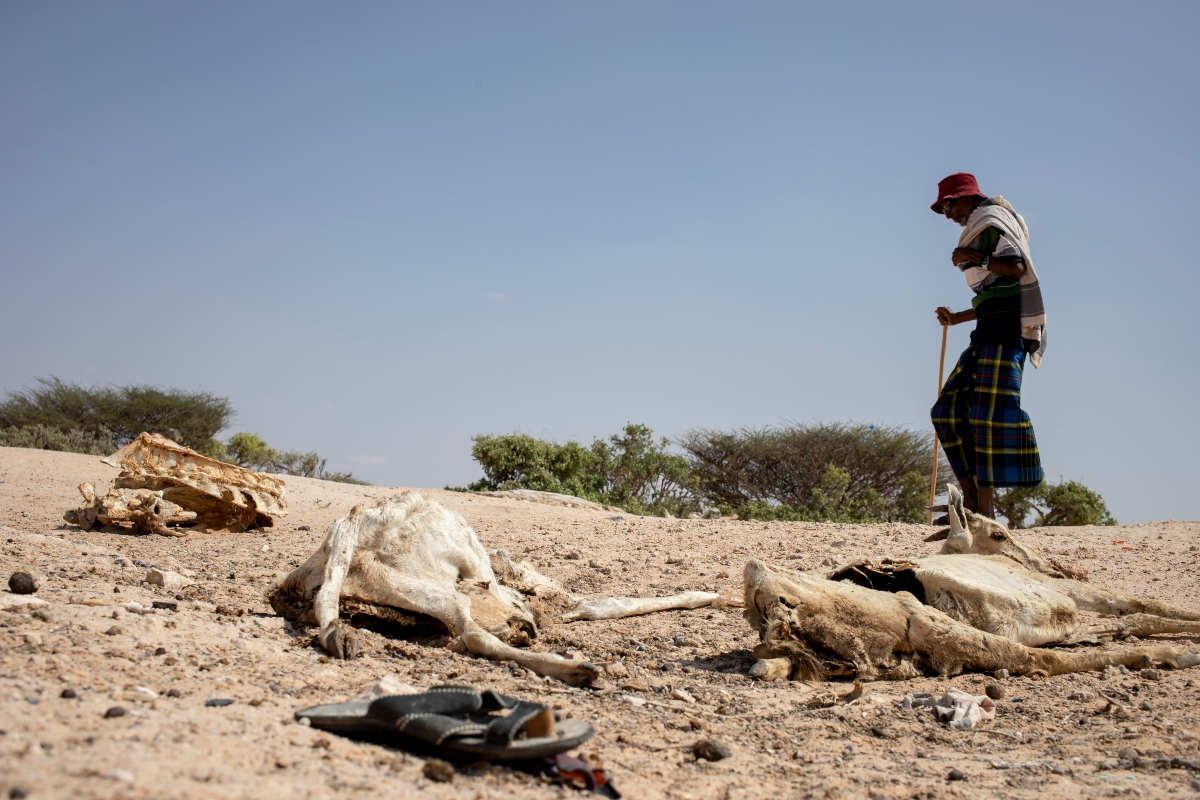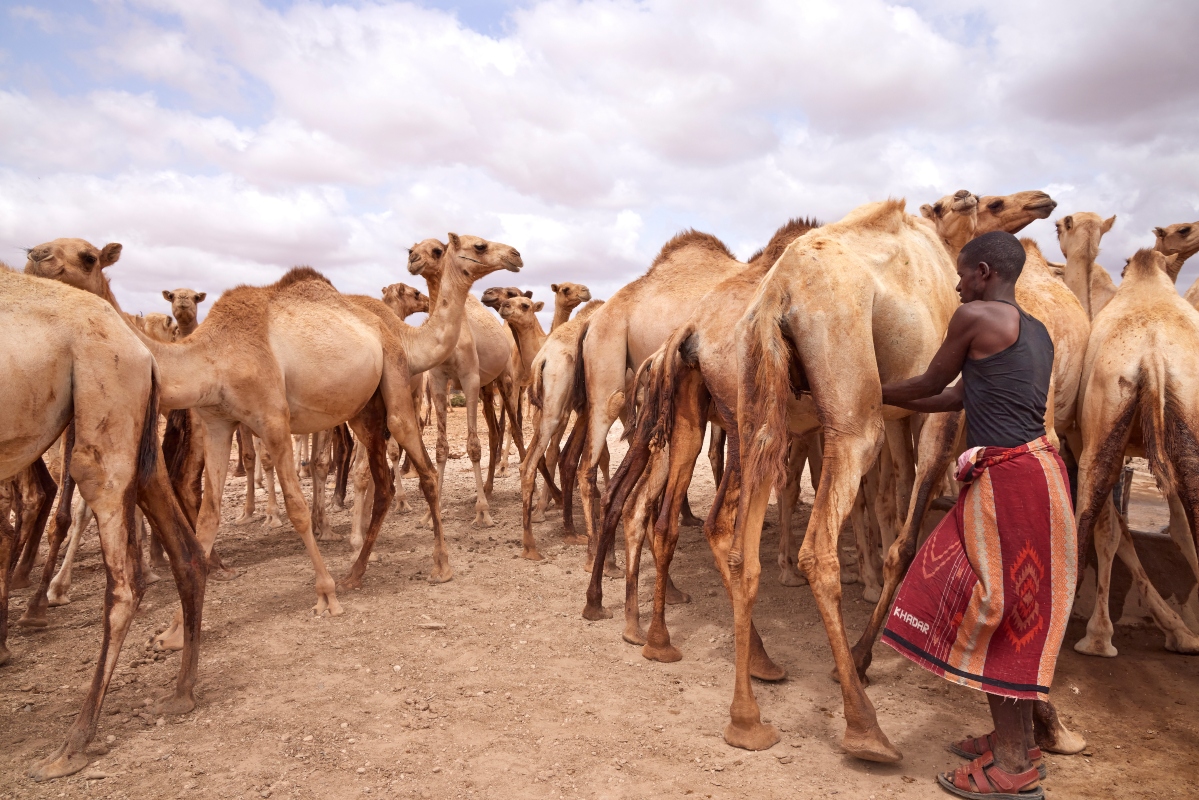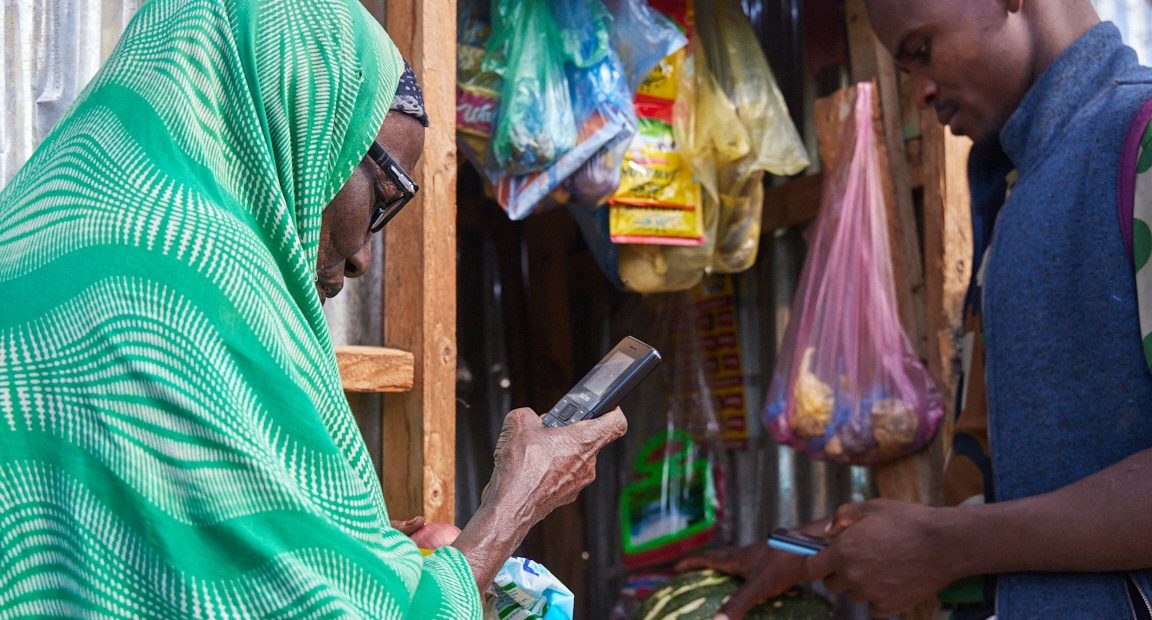There’s a perfect storm raging in the Horn of Africa. Prolonged drought, conflict, global inflation, and now a shortage of grain due to the Ukraine conflict–has millions of people facing food insecurity. In Somalia alone, over 7 million people are in urgent need of food and water—that’s half the country’s population and equal the populations of Los Angeles and Chicago, combined. Despite all of this, the ICRC has been addressing food insecurity for decades in Somalia and other parts of the Horn of Africa and looking at alternative sustainable solutions. In this episode we speak with Alyona Synenko, an ICRC spokesperson in east Africa, about why we provide this emergency assistance and what long term solutions look like. We then turn to a story from Mohamed Abdille Abdi, an economic security expert in Somalia, who tells us about one assistance program and the challenges of distributing on the ground.

Millions of people in Somalia continue to face the severe consequences of the drought. Since the beginning of 2022, the ICRC has been scaling up its assistance and relief operations in the country, particularly for internally displaced people. (Photo Credit: Ismail Taaxta/ICRC)

Mohamed Abdille Abdi, an economic security expert with the Nairobi Delegation, says herding is a way of life for many communities in rural Somalia, and a main source of income. (Photo Credit: Abdikarim Mohamed/ICRC)

After Mohamed and his team visit these villages, they have the arduous decision to determine how much cash to give each household. They often have to ask tough moral questions. (Photo Credit: Abdikarim Mohamed)

The ICRC is also working with communities affected by conflict and climate to help them adapt their sources of income to include work like beekeeping to produce honey. (Photo Credit: Abdikarim Mohamed)

Other efforts are being made to help farmers adapt to climate change by providing them with drought-resistant seeds. (Photo Credit: Abdikarim Mohamed)
Important Links
Read more about the humanitarian consequences of climate and conflict: When Rain Turns To Dust
Learn more about the ICRC’s efforts to advocate for communities affected by conflict and global food insecurity.
Watch this video of Dadir Ahmed Adan running his store in the Shul Gadud camp for internally displaced peoples.
This episode is now available for the hearing impaired.
SCRIPT
There’s a perfect storm raging in the Horn of Africa, with prolonged drought, conflict, global inflation, and now a shortage of grain due to the Ukraine conflict.
Somalia is particularly hard hit. Over 7 million people are in urgent need of food and water—that’s half the country’s population and equal to the populations of Los Angeles and Chicago, combined.
The numbers are unfathomable. They represent millions of human stories and life experiences that don’t make headlines.
Despite all of this, the ICRC has been addressing food insecurity for decades in Somalia, offering emergency assistance in places where armed conflict and violence is an everyday reality. But there’s an increasing need for alternative solutions, to improve people’s resilience over the longer term.
Since the beginning of the year, the Somalia delegation has distributed unconditional cash assistance to more than 150 000 vulnerable households, geared up its primary health response, and improved communities’ access to water.
All this to help affected and hard-to-reach populations and displaced people.
[ALYONA] “Due to our neutrality, we managed to get access to places where no other humanitarian organizations can reach.”
Alyona Synenko, an ICRC spokesperson for east Africa, explains the current situation on our show today. And then, we’ll hear from our colleague Mohamed Abdille Abdi, to learn about one emergency assistance program—and how it works on the ground.
I’m Dominique Maria Bonessi and this is Intercross, a podcast that offers a window into the work of the International Committee of the Red Cross and shares the stories of those affected by war and violence.
[Intercross musical interlude plays]
Alyona joins us now. She’s been with the organization for more than 13 years working in conflict affected countries, including recently Ukraine. She’s first going to talk about where the ICRC focuses its assistance in Somalia, our mandate, and why emergency solutions are not enough for those experiencing both climate and conflict.
[ALYONA] “If we look at Somalia, our response is concentrated in the southern and the central parts of Somalia. That is the bulk of our intervention today. And these are the areas that are not only very seriously hit by the drought. But they are also the most conflict affected areas and Somalis have endured one of the most protracted conflicts in the region. It has lasted for over 30 years. And of course, it has very seriously undermined people’s resilience. And it makes them much more vulnerable to the extreme weather events like the droughts that they are facing right now.”
“What we aim to do is to maintain dialogue with all the armed bearers with everyone who is present on the ground, I think Somalia is really the perfect illustration of that, Due to our neutrality, we managed to get access to places where no other humanitarian organizations can reach…But that is our objective because people who are living in areas that are affected by the conflict, they are much more vulnerable, much more exposed to the weather shocks because there’s no humanitarian access. There are very often no safe network systems that could help them soften the blow.”
[BONESSI] And how are we advocating for those vulnerable populations in places like Somalia and other parts of the Horn of Africa?
[ALYONA] “So when we speak about the global problems that we all face today in the world, like climate change. Our role is to remind, and to advocate that actually people who are living in the countries that are devastated by armed conflict, they should not be left out, they should not be forgotten. And when we speak about the climate funding about infrastructure project, they should not be put at the bottom of the list because they are the ones who are the most vulnerable to these situations, because the prolonged conflicts just undermine their resilience.”
[BONESSI] Cash assistance is just one of many ways the ICRC, along with the Somalia Red Crescent Society, works to mitigate the effects of climate change for those living in areas affected by conflict and violence.
We also support primary health care clinics, hospitals, emergency mobile clinics, and stabilization centers to treat those suffering from malnutrition.
But while humanitarian needs are on the rise, the surge in energy prices further escalates the cost of ICRC operations.
We estimate that we could see deficit funding deeply felt in places like the Horn of Africa. And that threatens our ability to help those suffering from conflict, climate, and food insecurity in the future.
So, in parallel to our emergency response, what are some of the long term projects the ICRC is working on to create sustainability?
[ALYONA] “There are different types of projects that we do. A project to improve access to water because basically the source of the problem, why many, so many people lost their livelihoods and had to, had to leave their homes and move to the camps because there is no water. We work with farmer cooperatives, because we realized that when they work together, working together in cooperative, they have higher chances of surviving the drought than working individually. We support them with drought resistant seeds, with fuel for irrigation with fertilizer, with training to help them better adapt to these extreme weather conditions. We also try to help as much as possible to help people diversify their income sources like for example, if Somalis, they traditionally, they are largely they depend largely on their livestock, we also have projects where we teach them how to produce honey. Because if you lose your livestock, it means that you would still have something to rely on something to, to help you to get by.
So again, I will not tell you that we have it figured but definitely these extreme weather events, we can no longer look at them and treat them as emergencies because they have become so frequent, and so severe that they have just become a new normal, and people are trying to learn to live with them. And our job is to adapt our programs, and our job is to help people build resilience, and to be better prepared to these situations.”
Thank you Alyona.
[Pause bring up music]
And now we turn to my colleague Mohamed Abdille Abdi, an economic security expert who’s been with the ICRC for almost five years. Mohamed is acutely aware of the consequences of the conflict in Somalia. He experienced them firsthand as a Somali refugee living with his family displaced in Kenya, just over the border.
[MOHAMED] “I grew up in this impoverished setting. And I always looked forward to having decent education that can change my life, of course and change the lives of the of the communities I came from. I feel now that I am someone who is an adult educated, it’s a payback time to communities.”
Mohamed and his team have the arduous job of deciding who gets cash assistance from the ICRC.
The Somalia delegation has distributed cash assistance to almost one million people this year, but conditions on the ground are making it more more difficult.
Before any money is handed out, Mohamed and his team of economic security experts need to figure out who is in the most dire need and how much to give them.
[MOHAMED] “And once the target villages are identified, we call them priority zones. Once these identified, we get to the communities, and once we are in the communities, the communities are now grouped into different sections based on their vulnerabilities. So it’s the vulnerability level of the community and the nature of humanitarian need that they have, that we normally look at.”
To start this operation, the team will drive hours on mostly dirt roads until they arrive in these remote areas of Somalia. Mohamed describes one remote herding village.
[Sound of brisk wind]
[MOHAMED] “Makeshift houses, these are temporary shelters, made of some old clothes, all the pants collected probably from a you know, sometimes the things thrown by companies, and you know, so they use this old tents to make houses. And it’s a small house and normally these Somali communities, they have large household members, large household numbers. Ten family members could be living in a small shelter in a very bad condition, sometimes exposed to severe weather conditions, of high temperatures, high heats.”
Most of the people living in these villages are part of a herding community. Mohamed says that in Somali culture herding is part of their way of life and main source of income.
[Sounds of goats and sheep]
[MOHAMED] “It is a source of, of course, milk and meat, and transportation as well. But it serves other purposes like the camel. Camel is a source of pride for the Somali community, it has a special status. It is seen as a, as a, you know, a special gift from God. And it is used to settle feuds, you know, blood settlement among, community whenever there’s conflict.”
Due to the tight-knit nature of the community, Mohamed and his colleagues need to quickly build rapport with the community to be able to assess their needs.
[MOHAMED] “Trust is a very important element to build on ways you can work with communities, if you don’t build trust is always that suspicion, there’s always lack of sharing information, if there is no trust. So, we build trust by showing humanitarian integrity, by being professional.”
Mohamed and his colleagues will then find an opening to start dialogue with the community. They go to local committees, authorities, and religious heads. Then they organize focus groups for anyone in the community to come and voice their concerns or needs. And finally, they’ll make their way to individual households to interview people in a more private settings.
The work takes weeks to build trust, arrange meetings, and evaluate the needs. Mohamed has taken notes of the changes to the community.
[MOHAMED] “Last year, when I was in the field, the situation was very dire. The land was so dry, they were no vegetations. So the livestock are in very bad conditions, those who are surviving, many of them have died. So families have no source of income, they have no source of milk, no meat, no nothing.”
When Mohamed went back this year, the situation had only grown more dire with two straight years of no rain.
[MOHAMED] “The rains have failed. Last year it failed this year again, it has failed. We expected if people receive rains this year, at least they would have recovered from last year drought.”
The prolonged drought has directly affected herders like Kaha Ahmed, who has lost dozens of her goats and is unable to make money to buy food.
[Sound of goat being fed]
She tries to feed hay soaked in a bit of water to a small, emaciated goat, but it refuses to eat.
[Kaha Ahmed with English translation underneath] “There is lack of water. There is no food. This is how things are.”
[MOHAMED] “One story that I feel maybe I can share is I find a household members that are all children and the oldest 15 year old child heading the the family as the head of the household, the mother be you know, not there, long gone, orphans actually. And in another instance, the mother was living, but the mother has taken to survive and livestock to search for pasture. And there is apparently no pasture, but probably sort of, you know, frustration, and the children are just left behind in a very remote village with no access to food. And when I asked them, have you eaten anything, they say, No, some say, Oh, just one time, because you noticed Somalis have that social network, of course, where people support each other. During these times, of course, it’s something common around the world. But here, it’s highlighted because of this drought situation. So that social network, or social support of assisting each other is also kind of dwindling, because everyone is really at a breaking point.”
Before leaving the village Mohamed and his team make their final assessment of how the aid will be distributed.
[MOHAMED] “It is really difficult at this time is almost everyone is at the same situation, when you collected this information, people are really, you know, affected by this humanitarian situation, this droughts compounded by this conflict, it is very hard even to see who is really affected and who is not. People are equally affected.
Often, they’re asking tough moral questions.
[MOHAMED] “Is there really a difference between these two households?”
Who is worse off? The household with multiple children, maybe an infant, maybe no parents, and then who has eaten? Have they had one meal a day or two or none? All these questions are a matter of life and death.
[PAUSE]
Mohamed and his team find themselves in an almost impossible situation, asking do they give more cash to the people they’re already helping, or do they give less cash but reach more people?
[MOHAMED] “It’s the minimum basket a family can survive, and it comprises of food and nonfood items.
[LONG PAUSE]
In each region of the country and depending on the severity of the humanitarian situation, the minimum amount a family or individual is given can vary.
Given the 30% increase in commodities prices this year, the average distribution in Somalia was around $90 per family. This year there have been three rounds of cash support like this totaling more than $28 million.
For people like Dadir Ahmed Adan, who is currently living in Shul Gadud camp for internally displaced people, he’s managed to stretch his $90. He ended up in the camp because he says all of his livestock perished in the drought.
[Dadir Ahmed Adan with English translation voiceover] “When I received the money, I used 50 US Dollars to open a small shop. I am using the rest of the money to buy food for my children.”
[Sounds of people speaking in audibly at Adan’s store in IDP camp]
Dadir stands outside his makeshift store in the camp selling small amounts of produce like watermelon and tomatoes, and some non-perishable foods like tea and milk powder. He’s building his own resilience, but ultimately there are millions of other who won’t have access to this assistance as the compounding crises worsen.
Long-term the ICRC is calling on the international community to move toward a more sustainable response and strengthen the capacities of communities, like Dadir’s.
This will help vulnerable communities recover and adapt their livelihoods.
Thank yous this week go to my colleagues in Nairobi, Abdikarim Mohamed Abullahi, Anisa Hussein Dahir, Sanela Bajrambasic, and Alyona Synenko.
And we want to hear from you. What did you think of this program?
You can respond on Twitter to our handle @ICRC_DC or contact us through our website, that’s intercrossblog.icrc.org. While you’re there you can see all of our most recent episodes and subscribe to our newsletter, so you never miss a podcast.
See you next time on Intercross

